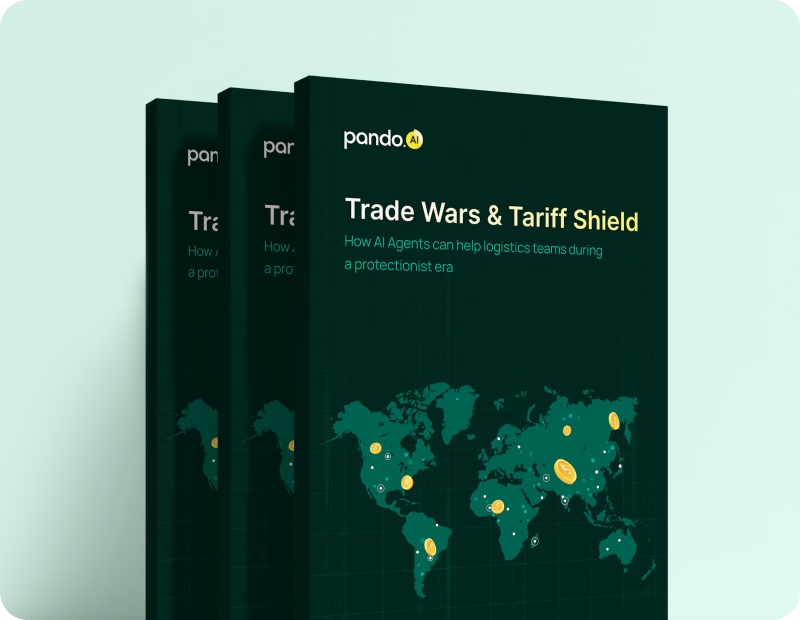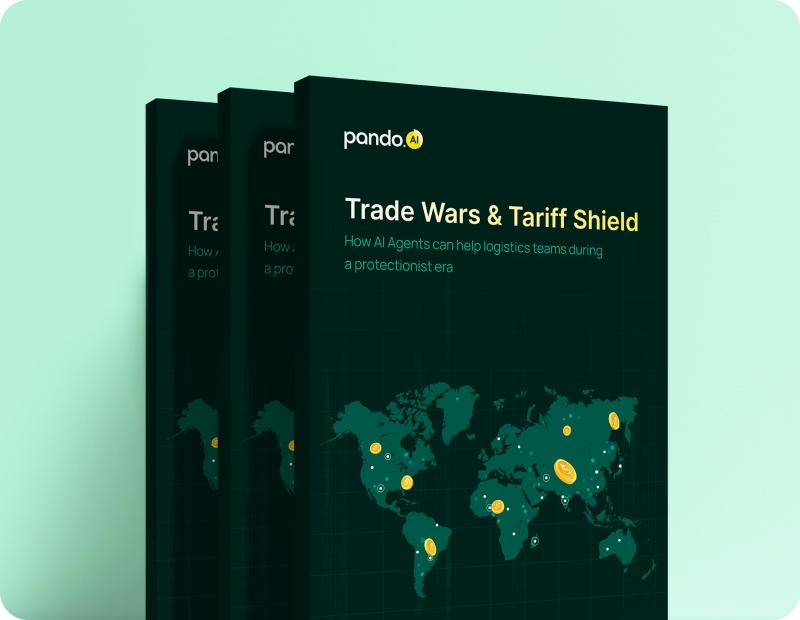-
Products Products
- Industry
- Initiatives
- Resources
- Company
- Book a demo

Before you go: Logistics leaders just dropped the truth on AI
The State of AI in Logistics 2025 is here — no hype, just real conversations and raw insights.
What is multi-modal transportation and how to choose the right mode for your shipment
Multi-modal transportation is complex, but an efficient TMS simplifies coordination. Optimize logistics, reduce costs, and boost agility with the right system.
Published on September 19, 2024 • 8 mins read
Rohit Lakshman

Multi-modal transportation is complex, but an efficient TMS simplifies coordination. Optimize logistics, reduce costs, and boost agility with the right system.
Multi-modal transportation is a critical component of modern logistics, offering a seamless integration of various transport modes—such as road, rail, air, and sea—to optimize the movement of goods from origin to destination. By leveraging the strengths of each mode, multi-modal transportation provides a flexible and efficient solution that caters to the specific needs of diverse shipments.
However, choosing the right transport modes for your shipment requires a thorough understanding of factors such as cost, speed, environmental impact, and the nature of the cargo.
Explore the essentials of multi-modal transportation and learn how to select the most efficient shipping mode for your business needs. This guide breaks down the complexities of multi-modal logistics and offers practical tips for optimizing your supply chain.
Common modes involved:
- Road: Ideal for short distances and last-mile delivery.
- Rail: Suited for large volumes over long distances on land.
- Sea: Cost-effective for international shipping, especially for bulky goods.
- Air: Fastest mode, best for high-value or time-sensitive shipments.
The integrated approach of being multi-modal aims to optimize the supply chain by leveraging the strengths of each mode, thereby enhancing efficiency and flexibility.
Comparison with single-mode transportation
Single-mode transportation, where goods are moved using only one of the four major modes of transportation, may seem simpler but often fails to meet the demands of long-distance or complex supply chains. In contrast, multi-modal transportation combines various modes to capitalize on their strengths and mitigate their limitations.
For instance, consider a shipment of electronics from a manufacturing hub in Shenzhen, China, to a distribution center in Berlin, Germany. Using only road transport would be impractical and costly for such a long distance. However, a multi-modal approach could involve road transport from Shenzhen to the port of Shanghai, sea freight across the Indian Ocean, and through the Suez Canal to the port of Hamburg, followed by rail transport from Hamburg to Berlin.
This combination allows the shipment to benefit from the flexibility of road transport, the cost-effectiveness of sea freight for the long haul, and the efficiency of rail for the final leg. Additionally, this approach significantly reduces both transportation costs and carbon emissions compared to relying solely on road transport.
Multi-modal vs. Intermodal transport
Intermodal transportation, too, involves the use of multiple transportation modes but differs from multimodal transport solutions in handling goods. In intermodal, goods stay in the same container throughout the journey, minimizing handling and transfer points, and thus, potential damage.
Key differences and similarities
- Handling: Multimodal transport solutions may involve multiple handling points, while intermodal transport minimizes handling.
- Cost: Intermodal can be more cost-effective due to reduced handling costs, but multimodal logistics offers greater flexibility in mode selection.
- Efficiency: Multi-modal freight might be preferred for complex routes, while intermodal is ideal for standardized, high-volume shipments.
Intermodal transportation is more advantageous when you need to maintain product integrity and minimize handling points. In contrast, you may opt for multi-modal transport solutions when flexibility and the ability to tailor the route are your top priorities.
Multi-modal transport advantages
Multi-modal transportation offers several advantages that can enhance the efficiency and effectiveness of your supply chain. By combining different modes of transport, businesses can achieve cost savings, as the most economical option is selected for each leg of the journey. Additionally, this approach provides greater flexibility and reliability, allowing for more adaptable delivery schedules.
Consider a shipment of electronics being transported from China to the United States. By combining ocean shipping for the long-haul portion and rail transport for inland transportation, businesses can benefit from the cost-effectiveness of water transport while leveraging the speed and flexibility of rail. This multimodal approach not only reduces overall transportation costs but also improves delivery times and reduces environmental impact. The benefits of multi-modal transport include:
Cost efficiency
By selecting the most cost-effective mode for each leg of the journey, multi-modal transportation can significantly reduce overall transportation costs. For example, combining rail for long hauls with trucks for last-mile delivery can lead to substantial savings.
Pando's TMS optimizes this process, ensuring that every segment of the journey is as cost-effective as possible, helping companies maximize their budget.
Flexibility and Reliability
The ability to combine different modes of transportation offers unparalleled flexibility, enabling businesses to adapt to various shipment needs. Whether it's dealing with sudden demand spikes or navigating disruptions, the advantages of multi-modal transport include reliable delivery schedules.
Pando’s TMS enhances this adaptability, offering real-time insights and adjustments to ensure reliability and efficiency across all modes.
Reduced transit times
Multi-modal shipping can streamline the supply chain by integrating faster modes of transport where necessary. For instance, using air freight for urgent segments while relying on sea freight for bulkier, less time-sensitive goods can reduce overall transit times.
Pando’s TMS intelligently balances speed and cost, optimizing routes and schedules to ensure timely deliveries without unnecessary expenses.
Enhanced supply chain visibility
With modern TMS solutions, multi-modal transport offers enhanced tracking and transparency throughout the entire journey. Businesses can monitor each leg of the journey in real-time, ensuring that goods are on the right track and any potential issues are promptly addressed.
Pando's TMS takes this a step further, providing comprehensive visibility and advanced analytics to keep the supply chain running smoothly.
Environmental benefits
Opting for more eco-friendly modes for certain legs of the journey, such as rail or sea, can significantly lower the carbon footprint of shipments. By strategically combining modes, businesses can make greener choices without sacrificing efficiency.
Pando’s TMS facilitates this by suggesting the most sustainable options available, helping companies achieve their environmental goals while maintaining operational excellence.
Components of a Multi-Modal Transportation System
A successful multi-modal transportation system relies on several critical components. Infrastructure requirements, such as ports, railways, and highways, must be in place to support the different transportation modes. Effective logistics coordination is essential to ensure that each mode works seamlessly with the others, minimizing delays and maximizing efficiency.
Documentation and liability considerations are also crucial, as they govern the legal and financial aspects of the transport process. Technology integration plays a pivotal role in managing these components, providing the tools needed for tracking, communication, and optimization.
The components of a multi-modal transportation system are:
Infrastructure
Multi-modal transportation relies on robust infrastructure, including ports, railways, roads, and airports, all connected to ensure seamless transfer between modes.
Logistics coordination
Successful multi-modal logistics requires meticulous planning and coordination, often involving multiple carriers and regulatory bodies.
Documentation and liability considerations
Each mode may require different documentation, and liability can vary depending on the mode used. It's essential to understand these nuances to avoid legal issues.
Technology integration
Advanced technology, particularly TMS software, is crucial for managing the complexity of multi-modal transport, from route optimization to real-time tracking and advanced analytics for sustainability metrics.
Factors to Consider When Choosing Transportation Modes
Selecting the right transportation modes for a multi-modal shipment involves careful consideration of various factors. The nature of the goods, including size, weight, and perishability, will influence the choice of transport. The distance and route are also important, as they affect the cost and time of delivery.
Cost considerations, time sensitivity, environmental impact, and regulatory requirements must all be balanced to find the optimal solution. By weighing these factors, businesses can make informed decisions that align with their operational goals and customer expectations.
Nature of Goods (size, weight, perishability): Choose the mode based on the characteristics of your goods. For instance, perishable items might require faster modes like air or temperature-controlled containers.
Distance and Route: Longer distances might benefit from a combination of rail and sea, while shorter distances might be best served by road transport.
Cost Considerations: Weigh the cost of each mode against the value of the goods being shipped and the budget for transportation.
Time Sensitivity: Urgent shipments may require air transport, while less time-sensitive goods could be moved via sea or rail.
Environmental Impact: If reducing carbon footprint is a priority, opt for eco-friendlier modes like rail or sea.
Regulatory Requirements: Be aware of regulations that might affect the choice of transportation mode, especially for international shipments.
Evaluating Different Transportation Modes
Each transportation mode offers unique advantages and limitations, which is why careful evaluation is essential, particularly when considering sustainability. As companies strive to minimize their environmental impact, choosing the right mode of transport can play a crucial role.
For example, rail and ocean freight tend to have lower carbon emissions compared to road and air transport. Rail freight can move large volumes of goods over long distances more efficiently, while ocean freight offers an even more sustainable option for global shipments, thanks to its capacity for large-scale, fuel-efficient transport.
Each transportation mode has its own set of advantages and limitations, making it important to evaluate them carefully. Air freight offers speed and reliability but at a higher cost. Understanding these pros and cons is crucial when planning a multi-modal transport strategy.
Road transportation: Pros and cons
Pros: Flexibility, door-to-door service, ideal for short distances.
Cons: Higher emissions, traffic delays, and sometimes higher costs.
Rail transportation: Advantages and limitations
Advantages: Cost-effective for large volumes, lower emissions, reliable for long distances.
Limitations: Limited to areas with rail infrastructure, and longer transit times.
Sea freight: Benefits and challenges
Benefits: Highly cost-effective for large, heavy shipments; suitable for international trade.
Challenges: Slower transit times, subject to weather conditions, and port delays.
Air freight: When to use and considerations
When to use: Ideal for high-value, time-sensitive goods.
Considerations: High costs, limited cargo space, environmental impact.
Strategies for Selecting the Optimal Mode Combination
Selecting the optimal combination of transportation modes requires a strategic approach. Conducting a thorough shipment analysis is the first step, considering factors like the nature of the goods, distance, and delivery requirements.
Balancing speed, cost, and reliability is essential to meet both business objectives and customer expectations. Seasonal factors and market conditions should also be considered, as they can impact availability and pricing. Leveraging technology, such as advanced
TMS platforms, like Pando, can provide valuable insights and tools to make the best mode selection, ensuring a smooth and efficient multi-modal transport process.
Subscribe to Pando blog and Crossroads newsletter now!
Stay up to date with the latest logistics, transportation, and supply chain tips and news.
Subscribe Here!













